Bookmakers Profit Margin – Top Bookies With Best Odds

Many punters, especially novices, get blinded by the bonuses that sportsbooks offer. 300% deposit bonuses, free bets, and all the other flashy betting promotions that best online bookmakers offer are hard for bettors to pass up.
The punters wonder how the bookies can make such huge profits by giving away such large chunks of bonus money so freely. They want to know how the bookies stay in business despite all of these generous gifts they so liberally bestow onto their customers.
The answer is juice. Vigorish. Gambling commission. The margin. Call it what you want. It is the reason that sportsbooks are collectively raking in billions of dollars every year.
They make their profits by nickel and diming the sports bettors on each and every bet they lay. This is the bookies profit margin. Those glitzy bonuses that some punters are so enchanted by are the power-bait that catches the big fish. Those generous sign up bonuses are small investments that international betting sites make and in the long run, they yield incredible returns.
The phrase “the house always wins” isn’t just some meaningless and overused adage. It is a fact. Any doubters only need to do a quick internet search to find out how much money this gambling industry makes.
What is the Bookmaker Profit Margin?
In a nutshell, the bookie’s profit margin is the vigorish which is like a small commission that is taken from every bet. To illustrate this, let’s use a coin toss as an example. A coin toss is, in essence, a 50-50 proposition.
If you and a friend decide to try real money sports betting $10 on a coin toss then you both have a 50% chance of winning. This is a true even money proposition. And betting on even odds is also called EVS betting. You call heads, your friend calls tails and the coin is tossed. One of you wins and comes out $10 ahead. This is because you and your friend made this wager using true odds. But for more information about this topic, you can read our article about betting odds explained.
When bookies get involved, it’s a little different. Instead of giving you the true odds based on mathematical probabilities, the bookmaker will fudge the odds a bit in order to get their cut and give you implied probabilities. When you lay a bet on heads through the bookie, they will adjust the odds to something like 1.95 for heads and 1.95 for tails. We explain it more in detail in our guide on how do bookies set odds.
This means that if you win the bet, you will come out $9.50 ahead as opposed to $10. The bookmaker pockets the other $0.50. This is the bookie’s betting margin and this is how the sports betting companies make billions of dollars.
In a perfect world, traditional bookies and new bookmakers would get equal action on both sides which would eliminate even the smallest financial risk. The bookie would simply take the losing wager money and give it to the winners while collecting their margin.
It’s not a perfect world but these international gambling companies still have methods of minimizing their financial risks. The bookie may lose a bit of money on a given day but in the end, they make their margins and comfortably stay in business.
Top Bookmakers with the Best Odds in 13 December 2025 – Updated List
How to Calculate Odds Margins
A bookie’s odds margin can be figured out using this mathematical formula:
((1/Odds 1) *100+(1/Odds 2)*100)-100
We will use the above coin toss scenario for this example. The odds on Heads are set at 1.95 and Tails is also 1.95. Therefore:
((1/1.95)*100+(1/1.95)*100)-100
= (51.28+51.28)-100
= (102.56)-100
This reflects a margin of 2.56%
If you want to figure out the margin on a game with 3 possible results like win, draw, and loss then just factor in the third option in the same way. As an example we have Norrkoping @ 2.70, Draw @3.50, and Rosenborg @ 2.30:
((1/2.70)*100+(1/3.50)*100+(1/2.30)*100)-100
= (37.03+28.57+43.47)-100
= (109.07)-100
This reflects a margin of 9.07%
Let’s put this to practical use with real 2-way lines from a couple of trusted betting sites on an MLB game between the Atlanta Braves and the Cincinnati Reds. At Sportsbook A, the Braves line is 2.55 and the Reds are 1.57. At Sportsbook B, the Braves are 2.60 and the Reds are 1.56. Let’s compare the sportsbook’s profit margins:
Sportsbook A
((1/2.55)*100+(1/1.57)*100)-100
= (39.21+63.69)-100
= (102.90)-100
= 2.9%
Sportsbook B
((1/2.6)*100+(1/1.56)*100)-100
= (38.46+64.10)-100
= (102.56)-100
= 2.56%
Braves bettors will want to lay their bets at Sportsbook 2 and Reds backers will find marginally better value at Sportsbook A. But what else does this comparison tell you? That’s right, Sportsbook A’s odds margin is a little higher for this baseball game. Now let’s throw in a 3rd sportsbook’s odds and compare. Sportsbook C has the Braves listed at 2.50 and the Reds at 1.50:
((1/2.50)*100+(1/1.50)*100)-100
=( 40+66.67)*100
= (106.67)-100
= 6.67%
You can see that Sportsbook C has a significantly higher margin than both counterparts. It is quite obvious that if given the choice, savvy punters would not make either their Braves bets or their Reds bets at Sportsbook C. The return on both bets would be lower than the alternatives because the bookmaker is taking a bigger slice of the action.
How do Bookmaker Odds Margins Affect your Long-Term Winnings?
Let’s go back to our coin toss example. The true odds are 50-50. This means that in order to break even, a punter would need to win 50% of his long-term bets. When we factor in the bookie margin, this takes away from the punter’s winning amount which now means that the punter will need to win close to 53% of the coin tosses to break even. We can then apply this to a sportsbook with a higher margin. Maybe the math shakes out to the punter needing to win 55% or even 60% of the time to break even.
One or two percentage points might seem like a very negligible amount, but you should pay attention to maximum payout of bookmakers because every percentage point impacts long-term earnings. Even 1% shifts the balance significantly. This is why it is so critical that punters seek out the best odds. This is just one of the tips in our how to beat the bookies guide.
How can you Find the Best Odds?
Finding the best odds bookmakers is just like finding the best price on a particular pair of shoes. You need to shop around, maybe take a look at our top 100 bookmakers or look for some sports bonus codes. You may see your desired pair of shoes advertised at $99 in one store, $110 at another, and $129 at the third store.
Comparing free bets, money back betting offers or the odds is always important. In the Atlanta Brave vs. Cincinnati Reds example above, Braves backers have their choice of 2.60, 2.55, and 2.50. Which one would you take?
For a variety of reasons, safe betting sites have different margins on different sports and that makes it more interesting. You may find that your sportsbook consistently offers the best odds on Premier League soccer, but their hockey odds are lower than other sportsbooks. This happens even at the bookies that offer the “accept all odds movement” feature, the “request a bet” feature, or the “edit my acca” feature. Still, if you prefer betting on lower odds, we suggest taking a look at our best staking plan for low odds. We also recommend the “low odds vs high odds” guide that will help you choose your final strategy. Basically, we have a guide for everything – even about making a living on Betfair or about betting scams and how to avoid them.
This is one of the biggest reasons why so many smart sports bettors use multiple sportsbooks. By analyzing margins and closely comparing odds, sports bettors give themselves their best chance of having long-term success. Don’t exclude betting shops when looking for good odds. In this case, you would be sharbing instead of arbing. If you have deeply analyzed the margins and odds, hedge betting is also a great alternative.
Choose one of the above legal betting sites or maybe play at one that offers Best Odds Guaranteed or Enhanced Odds promotions.

Bet £10 & Get £30 in Free Bets For New Customers
Min deposit requirement. Free Bets are paid as Bet Credits and are available for use upon settlement of qualifying bets. Min odds, bet and payment method exclusions apply. Returns exclude Bet Credits stake. Time limits and T&Cs apply.
Best odds margins FAQ:
Betting margins are the difference between the odds (an implied probability) the customer is offered to bet at, and the true probability of the outcome.
To calculate the margin for a two-way market, like basketball or tennis use this example: (1/decimal odds) *100 + (1/decimal odds) *100 = Betting margin. ... (1/2.48) *100 + (1/1.54) *100 = 40.3 + 64.9 = 105.2 = 5.2% margin. ... (1/2.50) *100 + (1/1.50) *100 = 40 + 66.6 = 106.6 = 6.6% margin.
The bookmakers are looking first at some criteria like, prior form, statistics, historical precedents and some experts advices.
In a nutshell, the bookie’s profit margin is the vigorish which is like a small commission that is taken from every bet.













